Archive for Places to go
February 14, 2006 at 10:26 am · Filed under Places to go
Let me cut right to the chase: you must visit Big Bend National Park. It is hard to do, and in this country where nearly everything is easy to get to, that should be reason enough to go. But Big Bend is so much more.
This mammoth park, located in a remote corner of Texas, is an incredible amalgamation of history, native culture, geology, desert life, and scenic beauty. Stretching nearly 60 miles from east to west, it is so large and diverse that you need two weeks to begin to see most of the highlights. Three distinct ecosystems are represented here. And really, the only way to see it is to get out of your car and start hiking.
For this reason, visiting the park with a recreational vehicle is a great choice. Ten years ago, Eleanor and I tent camped in the park for four nights. We had an unforgettable time in our quiet little campsite, two miles off the paved road and totally private. But I remember that after two days we were forced to drive to Terlingua (30 miles away) to recharge our video camera batteries, and it was three dusty days before we got a bath one night in a hot spring. In the comfort of the Airstream, we find we can enjoy the park just as much and still have light, heat, and a hot shower at the end of the day.
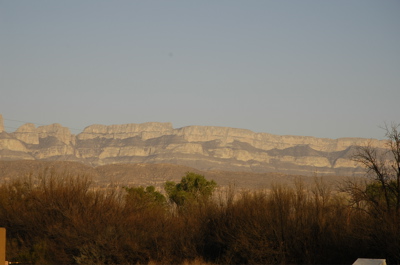
Sunset on the limestone cliffs near Rio Grande Village
I can’t tell you everything about Big Bend because it would fill a book. Suffice to say that anyone who enjoys a hike will never be bored here. That leaves out a lot of people, I know. Janie was in the little store by “Rio Grande Village” (not a village at all, but simply two adjacent campgrounds), when a woman walked in and asked, “Where can I go to see something beautiful?” The store clerk was helpful and offered a few suggestions. But Janie thought, “Just open your eyes!” Indeed, there’s almost nowhere you can turn in Big Bend where there isn’t something beautiful or at least interesting.
I am glad we brought Emma up from an early age to enjoy hiking. We took her on hikes Saturday, Sunday, and Monday. On Sunday we did three hikes, each about one to two miles. She was fun to have around, and interested in everything. Two months in the desert has given her a real appreciation for the amount of life to be found here.
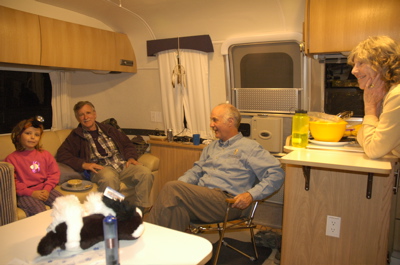
Catching up after a day of hiking
It was a very full weekend. We saw two hot springs and hundreds of fossils, pictographs and petroglyphs, natural watering holes in stone (abajos), and limestone cliffs lit pink in the sunset. We met Mexicans from the nearby town of Boquillas del Carmen and listened to their stories. We shot pictures of swallows flying into their cliffside nests, roadrunners, and javelina. We saw a desert fox running behind our path, and listened to coyotes barking just 50 feet from our trailer. And that was just the weekend!
So do I have to say it again? You must go to Big Bend when you can.
Having done all the short hikes on the eastern side of the park, we relocated today to the nearest town, Study Butte (pronounced “Stoody Beeyoot”). Here we have full hookups, wireless Internet in the rec room, and we are closer to the majority of the best hikes. So I can keep you updated for the next few days as we continue to explore the park.
Unfortunately, I can’t offer much in the way of pictures today. Bert has my camera. I left it in his truck today after our last hike, and I hope he has noticed and retrieved it by now. He and Janie elected to stay one more day in Rio Grande Village so they could check out a few more of the longer hikes. They will meet us here on Tuesday or Wednesday, and then I’ll be able to download over 100 new photos for our online album. Until then, I only have about a dozen shots to pick from for the blog.
I will also be posting an essay Wednesday on Gather, after I get my camera back. There is a sad story involving Big Bend and the Mexican people who live just across the border in Boquillas del Carmen. Both Bert and I were so taken with the tale that we took extra time to photograph and interview some of the Mexicans and I’ve written up their story. On Wednesday or later, you can read it by clicking the link to the left that says “Gather”.
February 10, 2006 at 9:00 am · Filed under Places to go
After a full day in the “office” I broke away to join Eleanor and Emma for a dip in the famous Balmorhea swimming pool. They say it is the largest spring-fed pool in the US, and the water is always 72 to 76 degrees and very clear.
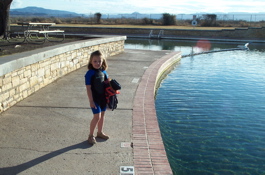
Emma, ready to put on her mask and snorkel!
It was tough to get psyched to go in the water because it didn’t warm up much today (about mid 60s). So we took the added precaution of wearing our shorty wetsuits. But it was great once we got in — great viewing, and plenty of creatures to see. Dozens of friendly black catfish, schools of shiny little fish, turtles, and ducks. Have you ever watched from below as a duck swims? It’s pretty funny.
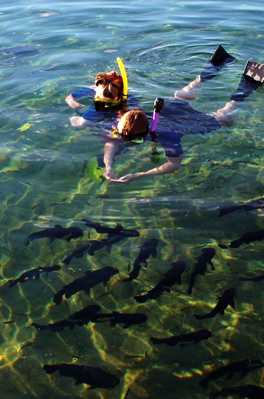
Eleanor and Emma meeting the catfish
At some points the catfish were so numerous, looking for handouts, we almost had to push them out of the way. And the water was as clear as my other favorite natural spring, Blue Spring in Florida. It’s definitely a great spot and I can imagine it’s very popular in summer.
Emma’s snorkeling is coming right along. She’s comfortable in water over her head, not afraid of undersea animals, she can tread water, give hand signals under water, and she can clear her mask without surfacing. We still need to work on a few skills, but we’re all very pleased with her progress at age 5 and a half.
Today we are heading to Big Bend National Park for the weekend. Our plan is to meet Bert, Janie, and their friend David, at Rio Grande Village, which is a campground deep inside the park on the east side. We’ll be very close to petroglyphs and a hot spring. I’m looking forward to seeing them again. Wednesday night we were up to nearly midnight telling stories and laughing!
I won’t be able to update the blog from Rio Grande Village, and our cell phones won’t work either. We’ll be gloriously cut off from society for the weekend. There are few services in the park and that’s the way people like it. So we’ll catch you up on Monday. Expect some good pictures!
February 7, 2006 at 8:11 pm · Filed under Places to go
Before I get into White Sands National Monument, I should tell you about our friends Bert and Janie Gildart, since they will be traveling with us for the next week or two. They are authors and photographers who work as a team to research and write hiking and nature books. Most recently they have published several books in a series for Globe Pequot Press on things to do in certain national parks. Bert also writes for Airstream Life magazine.
It’s great fun to travel with Bert and Janie because they are into hiking and photography (like us), and they seem to enjoy having Emma around. As I mentioned yesterday, they have a fairly new Airstream Safari 28 slide-out. They are parked just down the hill from us at Oliver Lee Memorial State Park.
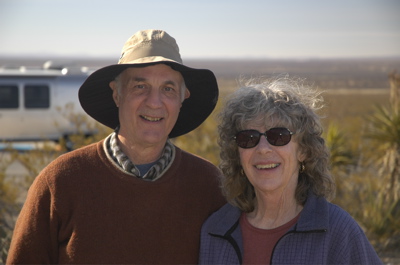
This is a nice state park, and it’s a shame we are not going to get to explore it properly. Behind us is a line of ragged mountains with a canyon that is begging to be explored. Below us to the west is the wide-open expanse of the White Sands MIssile Range. The view is inspiring. This morning I watched pink light of sunrise illuminate the mountains 40 miles to the west, and slowly fill the valley’s playas.
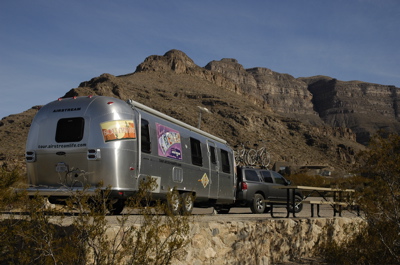
But instead of hiking here, we headed to White Sands. This park is basically a collection of huge dunes made entirely of gypsum sand. The sand blows southeasterly from nearby dry lakes, and without a river to wash it away, piles up. Normally gypsum is water-soluble, so gypsum sand is very rare. But here conditions are perfect for it to accumulate in marvelous heaps with textures and designs made by the wind.
After a little orientation at the Visitor’s Center, we decided to go for the longest hike here, the 4.6 mile Alkali Flats route. Driving out on Dune Drive gives one the impression of driving on a frozen lake. The road and parking lots are graded white gypsum sand. The occasional buildings look like ice fishing shanties.
Hiking on the sand is difficult work. We were surprised that after an hour we had only managed to go one mile. But of course, we spent a lot of time paused to let Emma play in the sand. Every dune is a fantastic opportunity, for play (sliding down the dunes on a plastic sled is encouraged), animal track identification, and photos.
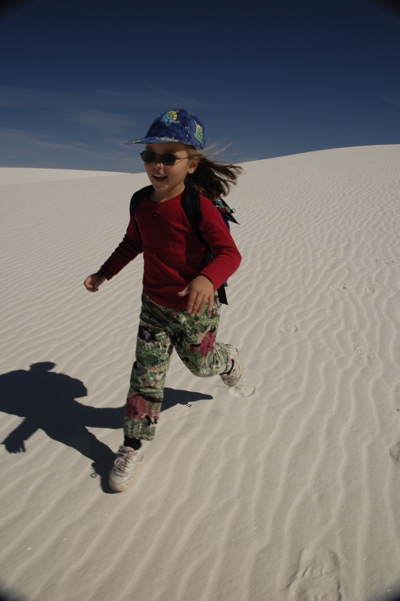
The hike took us over five hours to complete. By the time we got back, we were exhausted and my camera battery was dead. But I was satisfied with the photos I got, and I think Bert was as well. He shot several rolls during the hike. I’ve posted some photos on Flickr tonight if you want to check them. Click the link to the left that says “Pictures”.
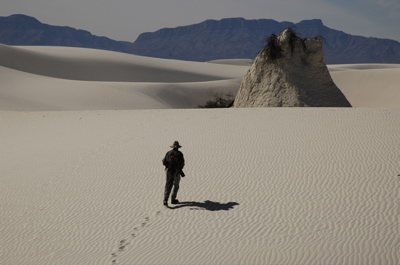
Emma earned another Junior Ranger certificate, her third. She’s getting into it now. And we of course picked up another stamp in our National Parks Passport book. When I went to stamp the book, I was surprised to find we were last in White Sands National Monument on Feb 4 2000 — almost exactly six years ago. I hope we are back soon. There’s a lot more to do in this area.
February 5, 2006 at 9:51 am · Filed under Places to go
Wow, we’re worn out. We’ve spent the last two days being tourists and it’s tiring. Today is going to be a slower day to catch up on business and relax a bit.
The big event of yesterday was the Pima Air & Space Museum. Fair warning: if you find wandering around 80 open acres and four hangars looking at old airplanes (primarily WW II through 1970s era) to be dull, skip down to the picture of Emma, below.
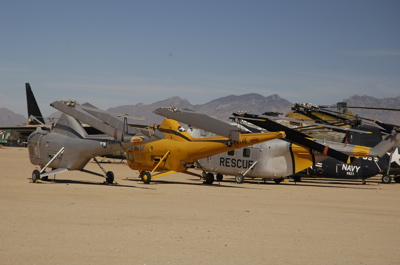
For Andy and I, it was pretty interesting. The Pima Air & Space Museum has an excellent collection of aircraft, thanks to the promixity of the Air Force Base next door, where hundreds of obsolete warbirds have been scrapped. Once in a while they just close the road separating the two locations and tow over another addition to the collection.
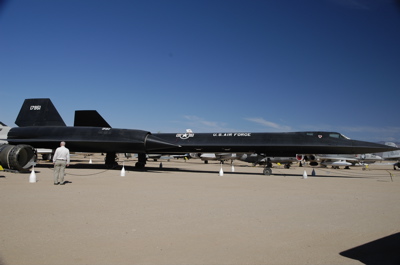
The highlights of the collection are an SR-71 Blackbird (2.5 times the speed of sound and built with slide rules!), several planes which were used as Air Force 1 including Kennedy’s, a Constellation, B-17, B-24, “Mig Alley”, plus many fighters, helicopters, a Guppy, an Electra (like Amelia Earhart’s) … there are hundreds of planes to look at. It’s a full day if you like aircraft, and they even sell an optional 2-day ticket. My advice: spring for the extra $5 for the tram tour to get more info and help keep the family from melting down. Also bring plenty of water, even in winter.

We also ran over to the ASARCO open pit copper mine for a tour later in the afternoon. It’s about 20 minutes south of Tucson on I-19. Unfortunately we arrived too late for the last tour (it leaves at 3:30). The Visitor Center is free and quite interesting if (again, like me and Andy) you like industrial topics. Emma bore up bravely but most of it was over her head. We’re going to owe her a major “kid day” pretty soon, for being such a good trouper.
I dropped Andy off at the airport at 5:30 this morning and so that ends our tourist phase in Tucson. We need to get the Nissan’s oil changed, load up for travel, pick up some necessities, and maybe try the pool. (They keep it heated to 90 degrees, we discovered.) Tomorrow, we head out for New Mexico, where we are planning to meet Bert & Janie Gildart in Alamogordo and visit White Sands National Monument.
February 4, 2006 at 7:39 am · Filed under Places to go
We are starting to see that Tucson has a tremendous amount to offer. No wonder so many snowbirds have landed here. We’re never going to see all the things we want before we have to head east.
Yesterday we drove about 48 miles over to visit Kartchner Caverns State Park, which was (as predicted) very good. We’ve seen a lot of caves over the years and this one is unique — well decorated, diverse, and comfortable inside at 68 degrees. They’ve installed a really good visitor’s center and the volunteer guide we had was first-rate. I would post pictures but they do not allow cameras on the tour at all. If you plan to go, be sure to visit the Arizona state parks website to get information first.
While were there, Emma and I went over their national map of famous caves in the US. We’ve visited several just on this trip (Lehmann Cave in Great Basin NP, the talus caves in Pinnacles Nat’l Monument, Kartchner) and soon we may drop in on Carlsbad if we have time. Last summer in our Argosy we visited Mammoth Cave in Kentucky, too. All great visits.
There’s a campground at Kartchner so you could stay overnight if you wanted to, but no much else to do in the immediate area. Tombstone and Bisbee are down the road a bit, but there are more convenient locations closer to those towns.
If you get hungry at Kartchner, you’re out of luck unless you have your RV with you. Benson is the nearest town with restaurants, about nine miles away. We can recommend Reb’s Cafe — a “real” place with reasonably good food. And they put plenty of the malt in the malted shakes, which makes Eleanor happy.
Our next stop was Sabino Canyon, which is part of the Coronado National Forest, northeast of Tucson. This is a great spot, also recommended. There’s a parking/admission fee but our National Parks pass (with Eagle hologram on the back) got us in for free. (If you visit a lot of US Forest Service spots, the pass and hologram are well worth the $65 annual fee.)
Sabino Canyon is a terrific place for easy hiking. You can choose paved roads suitable for cycling or strollers, or dirt trails that parallel the hills. There are horse trails, too.

Emma spots a roadrunner!
The scenery is great everywhere. For a really easy view, you can hop a tram up into the canyon and get off anywhere you want. The trams run all day, so you can design a hike that works for you, even one-way hikes that only go downhll. We got there late so we skipped the tram and just took a casual two mile walk so we could take our time and talk about what we spotted.
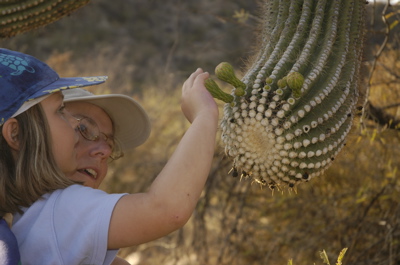
Emma gets a peek at the Saguaro fruit.
By the way, we are now in the Chihuahuan desert, rather than the Sonoran desert. It’s a not a lot different, but there are some variations in plants and animals. One animal that remains the same from the Mojave to here is the mountain lion, but of course we didn’t see any.
I spot so many unusual signs as we travel that I have started collecting them (photgraphically). Here’s my “Sign of the Week”.

February 2, 2006 at 11:18 am · Filed under Places to go
We are really lucky this week. The famous Tucson Gem & Mineral Show is in full swing this week, and it is great! All over the city, in dozens of venues, people have come from all over the world to buy and sell gems, minerals, pearls, jewelry, meteorites, fossils, crystals, giant geodes …. and Native American crafts, watches, rare coins … and kettle corn.
We started off fairly restrained, at the first venue we visited, not buying anything even though everything looked really great. In the second venue, I broke down and bought kettle corn for everyone. Eleanor bought a pair of cool bowls made of fossilized stone.
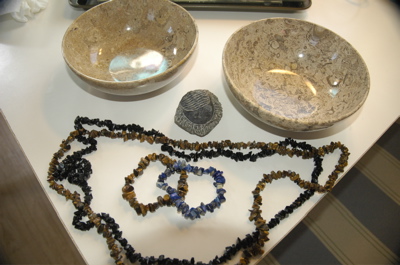
In the third and fourth stops, we completely lost control. Emma bought a trilobite fossil, Eleanor bought necklaces, and I bought a collectible watch. How can you resist? Everything is a good bargain, and the vendors will often drop their prices to wholesale just for the asking. It was a good thing the shows all closed up by 7 pm, so we were forced to go home.
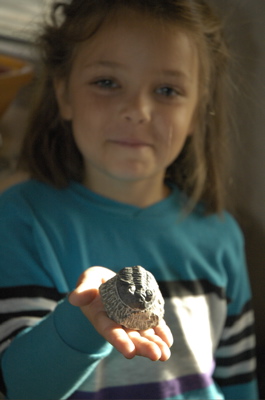
Emma and her trilobite
It is also a good thing we don’t have a house back in Vermont, or we would have bought much more “stuff” to put in it. I saw some amazing fossil sheets, as large as 5 ft x 3 ft, for ridiculously low prices. Those won’t fit in the trailer …
When you live in limited space, the key to buying things is that you have to decide what to get rid of at the same time. Something comes in, something goes out. We just don’t have the room to accumulate “stuff” so we try not to buy things we don’t really need. This shopping spree was definitely an exception.
We will go back to more of the show today (after we pick up Andy, our guest, at the airport) but hopefully we’ll just look, and not buy. It’s an amazing event and I can highly recommend it for anyone in Tucson this time of year.
January 29, 2006 at 8:37 am · Filed under Places to go
About an hour’s drive east of Patagonia are Tombstone, “The town too tough to die,” and Bisbee. We left the Airstream parked at 4th and Duquesne, and Charlie reading on a park bench in the center of Patagonia, and took off for a full day of exploration.
We had been warned that Tombstone is basically a tourist trap. Imagine something like “South of the Border” with an old west theme and you’ve got it. But we wanted to take a look and give Emma a chance to see a wild west show, so we strolled down the dusty gravel street of old Tombstone.
There is some real history here, but you’ve got to look closely. There’s a state historic park in the old courthouse ($5 admission), and many houses have plaques identifying their historic status. But around town you’ll also find a lot of reproduction buildings, tons of merchants with silly names ( “Pony Espresso,” “OK Café,” etc.) and people in period costumes with cell phones on their gunbelts.
It is old west history run ragged. But I should say that the locals were very nice and went out of their way to make sure everyone on the street was having a good time. And there is authenticity still alive in Tombstone. Some of the actors in the wild west show lead long trail rides up into the mountains as their primary vocations. Talking to them about their horses and their love of the open spaces made me realize the western spirit was still alive. It’s just different these days.
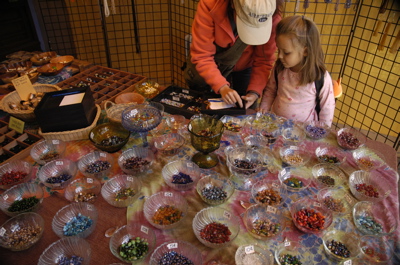
Shopping for beads in Bisbee
Still, it took only 90 minutes to feel like we’d seen enough of Tombstone (and that included 30 minutes in the wild west show), so we headed off to Bisbee, 30 miles down the road. Bisbee is a former copper mining town that now seems to be taken over by artists ““ which has made it an attractive and interesting place to visit, especially the downtown.
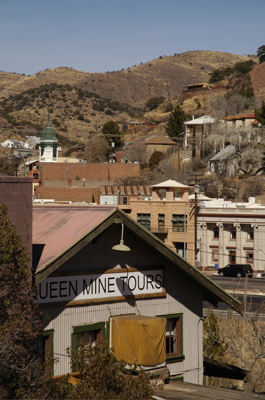
The major attraction of Bisbee is the Copper Queen Mine Tour, which takes you hundreds of feet beneath the surface of a hill to see how copper was mined from the 1800s through the middle of the 20th century. It’s a worthwhile visit, and there’s an RV park right on the premises that gives you easy walking access to downtown too.
I won’t give away too much about the mine tour, but here’s one thing you might see in there. Can you imagine what this piece of equipment is for? I’ll tell you in the next blog entry.
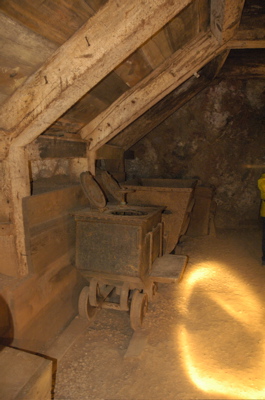
Mystery equipment in the mine?
There are two other “must see” things in Bisbee. One is the Bisbee Mining and Historical Museum, right downtown, in front of the Copper Queen Hotel. The other is The Shady Dell, a sort of campground/hotel filled with classic old aluminum travel trailers. You can spend the night in any of the restored trailers. (We featured The Shady Dell in a past issue of Airstream Life.) Amazingly, I completely spaced on The Shady Dell and forgot to drop in! Unbelievable “¦
There’s a lot to check out in Bisbee, so perhaps we’ll go again later this week. But we’ve got a lot on the schedule, including Kartchner Caverns, Pima Air Museum, and some great hiking. It’s going to be tough fitting it all in. Plus, we’ve got a houseguest coming on Thursday ““ or is that trailerguest? I’ll tell you about that later this week too.
« Previous entries ·
Next entries »




















